货币银行学 题库
- 格式:doc
- 大小:44.00 KB
- 文档页数:6
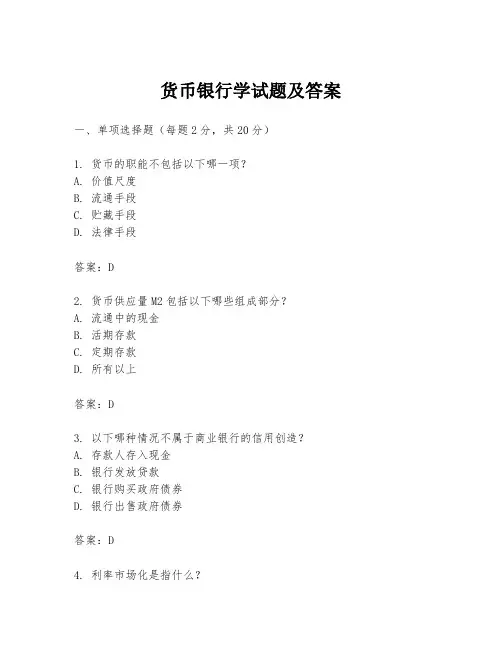
货币银行学试题及答案一、单项选择题(每题2分,共20分)1. 货币的职能不包括以下哪一项?A. 价值尺度B. 流通手段C. 贮藏手段D. 法律手段答案:D2. 货币供应量M2包括以下哪些组成部分?A. 流通中的现金B. 活期存款C. 定期存款D. 所有以上答案:D3. 以下哪种情况不属于商业银行的信用创造?A. 存款人存入现金B. 银行发放贷款C. 银行购买政府债券D. 银行出售政府债券答案:D4. 利率市场化是指什么?A. 政府规定利率B. 市场决定利率C. 银行决定利率D. 个人决定利率答案:B5. 货币乘数是指什么?A. 货币供应量与基础货币的比例B. 货币供应量与存款准备金的比例C. 基础货币与存款准备金的比例D. 存款准备金与基础货币的比例答案:A6. 以下哪种工具不属于中央银行的货币政策工具?A. 公开市场操作B. 存款准备金率C. 利率政策D. 银行监管答案:D7. 通货膨胀是指什么?A. 货币供应量增加B. 货币供应量减少C. 物价水平持续上升D. 货币供应量与物价水平同时上升答案:C8. 以下哪种情况会导致货币需求增加?A. 利率上升B. 利率下降C. 收入增加D. 预期通货膨胀答案:C9. 货币的流动性是指什么?A. 货币的购买力B. 货币的贮藏价值C. 货币的流通速度D. 货币的易交换性答案:D10. 以下哪种情况会导致货币供应量增加?A. 银行提高存款准备金率B. 银行降低存款准备金率C. 银行提高贷款利率D. 银行提高存款利率答案:B二、多项选择题(每题3分,共15分)1. 以下哪些因素会影响货币需求?A. 利率水平B. 收入水平C. 物价水平D. 货币供应量答案:A B C2. 以下哪些属于商业银行的负债?A. 存款B. 贷款C. 银行债券D. 银行资本答案:A C D3. 中央银行的职能包括以下哪些?A. 发行货币B. 制定货币政策C. 监管金融机构D. 经营商业银行业务答案:A B C4. 以下哪些措施可以抑制通货膨胀?A. 提高利率B. 增加货币供应量C. 提高存款准备金率D. 减少政府支出答案:A C D5. 以下哪些属于货币政策的传导机制?A. 利率渠道B. 货币供应量渠道C. 信贷渠道D. 预期渠道答案:A B C D三、判断题(每题2分,共10分)1. 货币供应量增加一定会导致通货膨胀。
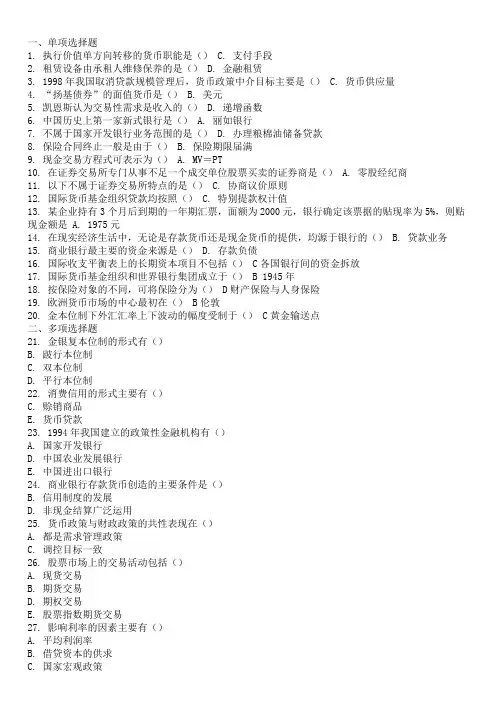
一、单项选择题1. 执行价值单方向转移的货币职能是() C. 支付手段2. 租赁设备由承租人维修保养的是() D. 金融租赁3. 1998年我国取消贷款规模管理后,货币政策中介目标主要是() C. 货币供应量4. “扬基债券”的面值货币是() B. 美元5. 凯恩斯认为交易性需求是收入的() D. 递增函数6. 中国历史上第一家新式银行是() A. 丽如银行7. 不属于国家开发银行业务范围的是() D. 办理粮棉油储备贷款8. 保险合同终止一般是由于() B. 保险期限届满9. 现金交易方程式可表示为() A. MV=PT10. 在证券交易所专门从事不足一个成交单位股票买卖的证券商是() A. 零股经纪商11. 以下不属于证券交易所特点的是() C. 协商议价原则12. 国际货币基金组织贷款均按照() C. 特别提款权计值13. 某企业持有3个月后到期的一年期汇票,面额为2000元,银行确定该票据的贴现率为5%,则贴现金额是 A. 1975元14. 在现实经济生活中,无论是存款货币还是现金货币的提供,均源于银行的() B. 贷款业务15. 商业银行最主要的资金来源是() D. 存款负债16. 国际收支平衡表上的长期资本项目不包括() C各国银行间的资金拆放17. 国际货币基金组织和世界银行集团成立于() B 1945年18. 按保险对象的不同,可将保险分为() D财产保险与人身保险19. 欧洲货币市场的中心最初在() B伦敦20. 金本位制下外汇汇率上下波动的幅度受制于() C黄金输送点二、多项选择题21. 金银复本位制的形式有()B. 跛行本位制C. 双本位制D. 平行本位制22. 消费信用的形式主要有()C. 赊销商品E. 货币贷款23. 1994年我国建立的政策性金融机构有()A. 国家开发银行D. 中国农业发展银行E. 中国进出口银行24. 商业银行存款货币创造的主要条件是()B. 信用制度的发展D. 非现金结算广泛运用25. 货币政策与财政政策的共性表现在()A. 都是需求管理政策C. 调控目标一致26. 股票市场上的交易活动包括()A. 现货交易B. 期货交易D. 期权交易E. 股票指数期货交易27. 影响利率的因素主要有()A. 平均利润率B. 借贷资本的供求C. 国家宏观政策D. 通货膨胀率E. 国际间的协议28. 可以作为一国官方储备的资产有()C. 黄金D. 特别提款权E. 固定资产29. 属于货币市场的金融工具有()C. 商业票据D. 回购协议E. 国库券30. 价值尺度与价格标准的区别在于()B. 价值尺度是基础,价格标准是指单位货币的含金量D. 价值尺度与价值规律有关,价格标准与价值规律无关E. 价值尺度代表社会必要劳动,价格标准由国家规定第二部分非选择题三、名词解释31. 间接信用指导32. 公开市场业务33. 基础货币34. 直接标价法35. 金融租赁四、简答题36. 简述商业银行的职能。
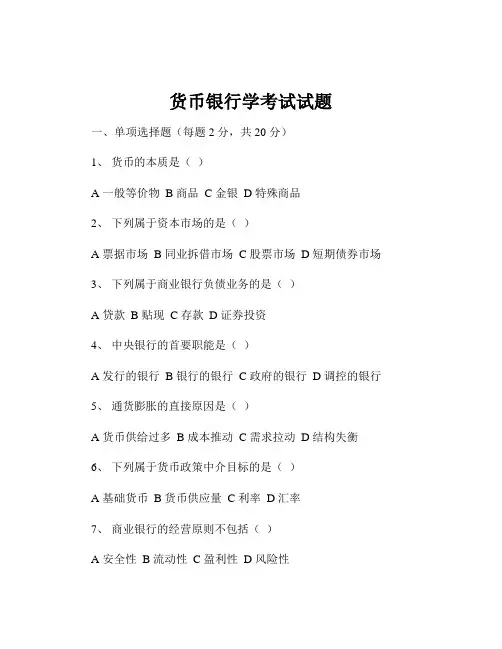
货币银行学考试试题一、单项选择题(每题 2 分,共 20 分)1、货币的本质是()A 一般等价物B 商品C 金银D 特殊商品2、下列属于资本市场的是()A 票据市场B 同业拆借市场C 股票市场D 短期债券市场3、下列属于商业银行负债业务的是()A 贷款B 贴现C 存款D 证券投资4、中央银行的首要职能是()A 发行的银行B 银行的银行C 政府的银行D 调控的银行5、通货膨胀的直接原因是()A 货币供给过多B 成本推动C 需求拉动D 结构失衡6、下列属于货币政策中介目标的是()A 基础货币B 货币供应量C 利率D 汇率7、商业银行的经营原则不包括()A 安全性B 流动性C 盈利性D 风险性8、信用的基本特征是()A 平等的价值交换B 无条件的价值单方面让渡C 以偿还为条件的价值单方面转移D 无偿的赠予或援助9、劣币驱逐良币规律发生在()A 平行本位制B 双本位制C 跛行本位制D 金币本位制10、下列属于直接融资的是()A 银行贷款B 股票融资C 票据贴现D 消费信贷二、多项选择题(每题 3 分,共 15 分)1、货币的职能包括()A 价值尺度B 流通手段C 贮藏手段D 支付手段E 世界货币2、商业银行的表外业务包括()A 担保业务B 承诺业务C 金融衍生工具交易D 租赁业务E 票据发行便利3、中央银行的一般性货币政策工具包括()A 法定存款准备金率B 再贴现政策C 公开市场业务D 消费者信用控制E 不动产信用控制4、影响利率的因素包括()A 平均利润率B 借贷资本的供求关系C 国家经济政策D 国际利率水平E 物价水平5、金融市场的功能包括()A 资金融通功能B 风险分散与风险管理功能C 价格发现功能D 经济调节功能E 优化资源配置功能三、判断题(每题 2 分,共 10 分)1、商业信用是现代信用的基础,银行信用是现代信用的主要形式。
()2、货币乘数等于法定存款准备金率的倒数。
()3、中央银行在公开市场上购买证券会增加货币供应量。
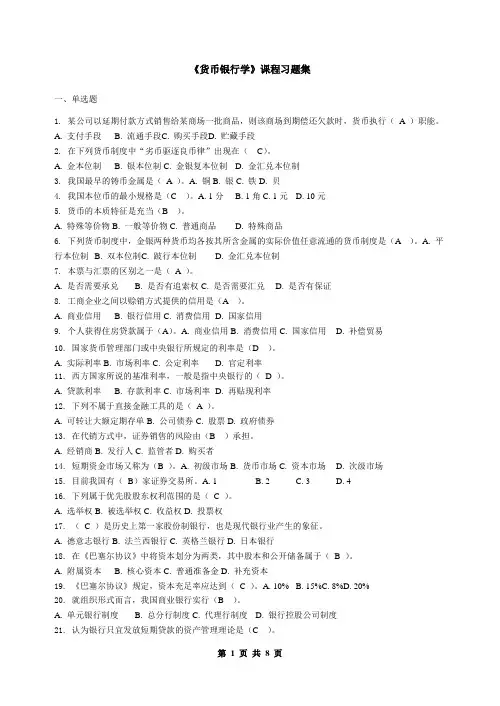
《货币银行学》课程习题集一、单选题1.某公司以延期付款方式销售给某商场一批商品,则该商场到期偿还欠款时,货币执行( A )职能。
A. 支付手段B. 流通手段C. 购买手段D. 贮藏手段2.在下列货币制度中“劣币驱逐良币律”出现在(C)。
A. 金本位制B. 银本位制C. 金银复本位制D. 金汇兑本位制3.我国最早的铸币金属是(A )。
A. 铜B. 银C. 铁D. 贝4.我国本位币的最小规格是(C )。
A. 1分 B. 1角C. 1元 D. 10元5.货币的本质特征是充当(B )。
A. 特殊等价物B. 一般等价物C. 普通商品D. 特殊商品6.下列货币制度中,金银两种货币均各按其所含金属的实际价值任意流通的货币制度是(A )。
A. 平行本位制 B. 双本位制C. 跛行本位制 D. 金汇兑本位制7.本票与汇票的区别之一是(A )。
A. 是否需要承兑B. 是否有追索权C. 是否需要汇兑D. 是否有保证8.工商企业之间以赊销方式提供的信用是(A )。
A. 商业信用B. 银行信用C. 消费信用D. 国家信用9.个人获得住房贷款属于(A)。
A. 商业信用B. 消费信用C. 国家信用 D. 补偿贸易10.国家货币管理部门或中央银行所规定的利率是(D )。
A. 实际利率B. 市场利率C. 公定利率D. 官定利率11.西方国家所说的基准利率,一般是指中央银行的( D )。
A. 贷款利率B. 存款利率C. 市场利率D. 再贴现利率12.下列不属于直接金融工具的是( A )。
A. 可转让大额定期存单B. 公司债券C. 股票D. 政府债券13.在代销方式中,证券销售的风险由(B )承担。
A. 经销商B. 发行人C. 监管者D. 购买者14.短期资金市场又称为(B )。
A. 初级市场B. 货币市场C. 资本市场 D. 次级市场15.目前我国有(B)家证券交易所。
A. 1 B. 2 C. 3 D. 416.下列属于优先股股东权利范围的是( C )。
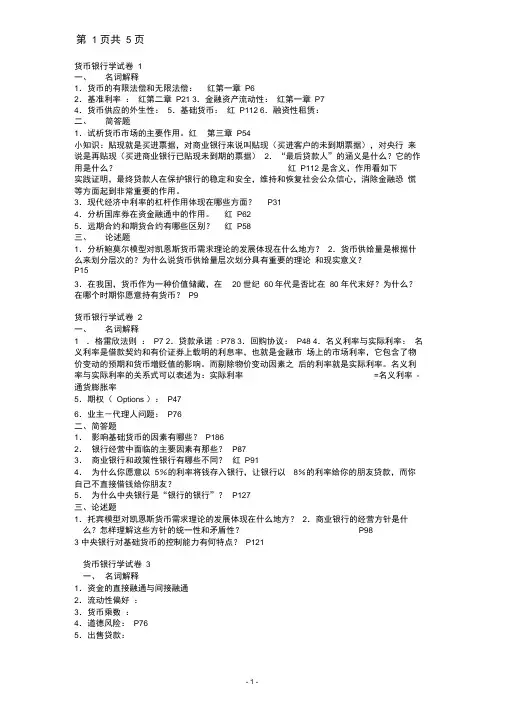
货币银行学试卷1一、名词解释1.货币的有限法偿和无限法偿:红第一章P62.基准利率:红第二章P21 3.金融资产流动性:红第一章P74.货币供应的外生性:5.基础货币:红P112 6.融资性租赁:二、简答题1.试析货币市场的主要作用。
红第三章P54小知识:贴现就是买进票据,对商业银行来说叫贴现(买进客户的未到期票据),对央行来说是再贴现(买进商业银行已贴现未到期的票据)2.“最后贷款人”的涵义是什么?它的作用是什么?红P112 是含义,作用看如下实践证明,最终贷款人在保护银行的稳定和安全,维持和恢复社会公众信心,消除金融恐慌等方面起到非常重要的作用。
3.现代经济中利率的杠杆作用体现在哪些方面?P314.分析国库券在资金融通中的作用。
红P625.远期合约和期货合约有哪些区别?红P58三、论述题1.分析鲍莫尔模型对凯恩斯货币需求理论的发展体现在什么地方?2.货币供给量是根据什么来划分层次的?为什么说货币供给量层次划分具有重要的理论和现实意义?P153.在我国,货币作为一种价值储藏,在20 世纪60年代是否比在80 年代末好?为什么?在哪个时期你愿意持有货币?P9货币银行学试卷2一、名词解释1 .格雷欣法则:P7 2.贷款承诺: P78 3.回购协议:P48 4.名义利率与实际利率:名义利率是借款契约和有价证券上载明的利息率,也就是金融市场上的市场利率,它包含了物价变动的预期和货币增贬值的影响。
而剔除物价变动因素之后的利率就是实际利率。
名义利率与实际利率的关系式可以表述为:实际利率=名义利率-通货膨胀率5.期权(Options ):P476.业主-代理人问题:P76二、简答题1.影响基础货币的因素有哪些?P1862.银行经营中面临的主要因素有那些?P873.商业银行和政策性银行有哪些不同?红P914.为什么你愿意以5%的利率将钱存入银行,让银行以8%的利率给你的朋友贷款,而你自己不直接借钱给你朋友?5.为什么中央银行是“银行的银行”?P127三、论述题1.托宾模型对凯恩斯货币需求理论的发展体现在什么地方?2.商业银行的经营方针是什么?怎样理解这些方针的统一性和矛盾性?P983 中央银行对基础货币的控制能力有何特点?P121货币银行学试卷3一、名词解释1.资金的直接融通与间接融通2.流动性偏好:3.货币乘数:4.道德风险:P765.出售贷款:6.商业贷款理论:二、简答题1.金融创新的主要内容是什么?P164 2.简述“螺旋式”混合型通货膨胀的基本要点和运行过程。

第一章货币与货币制度一、填空1、从货币本质出发,货币是固定充当()的特殊商品;从价值规律的角度看,货币是核算()的工具。
答案:一般等价物2、古今中外很多思想家和经济学家都看到了货币的起源与()的联系。
答案:交换发展3、银行券是随着()的发展而出现的一种用纸印制的货币。
答案:资本主义银行4、铸币的发展有一个从足值到()铸币的过程。
答案:不足值5、用纸印制的货币产生于货币的()职能。
答案:流通手段6、价格是()的货币表现。
答案:价值7、存储于银行电子计算机系统内可利用银行卡随时提取现金或支付的存款货币称为()。
答案:电子货币8、货币在商品交换中起媒介作用时发挥的是()职能。
答案:流通手段9、在金属货币流通条件下货币贮藏具有()的作用。
答案:自发调节货币数量10、一国流通中标准的基本通货是()。
答案:本位币11、没有商品(劳务)在同时、同地与之作相向运动是货币发挥()职能的特征。
答案:支付手段12、至今为止历史上最理想的货币制度通常被认为是()。
答案:金铸币本位制13、我国的人民币是从()开始发行的。
答案:1948年12月1日14、人民币采取的是()银行券的形式。
答案:不兑现15、欧元的出现对()提出了挑战。
答案:国家货币主权二、单项选择题:1、与货币的出现紧密相联的是()A、金银的稀缺性B、交换产生与发展C、国家的强制力D、先哲的智慧答案:B2、商品价值形式最终演变的结果是()A、简单价值形式B、扩大价值形式C、一般价值形式D、货币价值形式答案:D3、中国最早的铸币金属是()A、铜B、银C、铁D、贝答案:A4、在下列货币制度中劣币驱逐良币律出现在()A、金本位制B、银本位制C、金银复本位制D、金汇兑本位制答案:C5、中华人民共和国货币制度建立于()A、1948年B、1949年C、1950年D、1951年答案:A6、欧洲货币同盟开始使用“欧元EURO”于()A、1998年B、1999年C、2001年D、2002年答案:B7、金银复本位制的不稳定性源于()A、金银的稀缺B、生产力的迅猛提高C、货币发行管理混乱D、金银同为本位币答案:D8、中国本位币的最小规格是()A、1分B、1角C、1元D、10元答案:C9、金属货币制度下的蓄水池功能源于()A、金属货币的稀缺性B、金属货币的价值稳定C、金属货币的自由铸造和熔化D、金属货币的易于保存答案:C10、单纯地从物价和货币购买力的关系看,物价指数上升25%,则货币购买力()A、上升20%B、下降20%C、上升25%D、下降25% 答案:B11、在国家财政和银行信用中发挥作用的主要货币职能是()A、价值尺度B、流通手段C、支付手段D、贮藏手段答案:C12、下列货币制度中最稳定的是()A、银本位制B、金银复本位制C、金铸币本位制D、金汇兑本位制答案:C13、马克思的货币本质观的建立基础是()A、劳动价值说B、货币金属说C、货币名目说D、创造发明说答案:A14、对商品价格的理解正确的是()A、同商品价值成反比B、同货币价值成正比C、商品价值的货币表现D、商品价值与货币价值的比答案:C15、货币的本质特征是充当()A、特殊等价物B、一般等价物C、普通商品D、特殊商品答案:B三、判断题1、最早的货币形式是金属铸币。
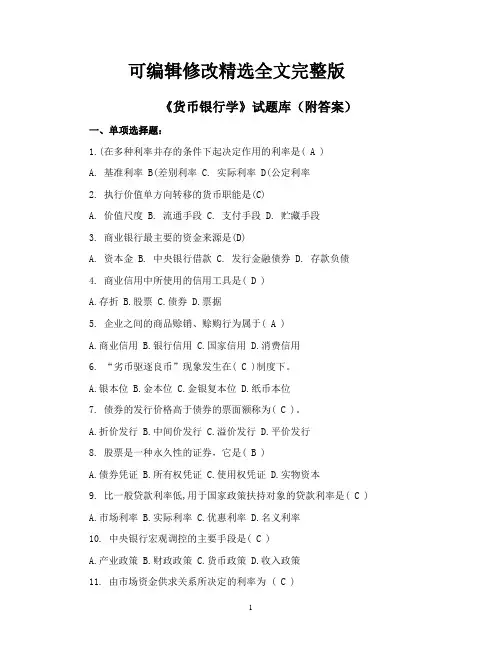
可编辑修改精选全文完整版《货币银行学》试题库(附答案)一、单项选择题:1.(在多种利率并存的条件下起决定作用的利率是( A )A. 基准利率 B(差别利率 C. 实际利率 D(公定利率2. 执行价值单方向转移的货币职能是(C)A. 价值尺度B. 流通手段C. 支付手段D. 贮藏手段3. 商业银行最主要的资金来源是(D)A. 资本金B. 中央银行借款C. 发行金融债券D. 存款负债4. 商业信用中所使用的信用工具是( D )A.存折B.股票C.债券D.票据5. 企业之间的商品赊销、赊购行为属于( A )A.商业信用B.银行信用C.国家信用D.消费信用6. “劣币驱逐良币”现象发生在( C )制度下。
A.银本位B.金本位C.金银复本位D.纸币本位7. 债券的发行价格高于债券的票面额称为( C )。
A.折价发行B.中间价发行C.溢价发行D.平价发行8. 股票是一种永久性的证券,它是( B )A.债券凭证B.所有权凭证C.使用权凭证D.实物资本9. 比一般贷款利率低,用于国家政策扶持对象的贷款利率是( C )A.市场利率B.实际利率C.优惠利率D.名义利率10. 中央银行宏观调控的主要手段是( C )A.产业政策B.财政政策C.货币政策D.收入政策11. 由市场资金供求关系所决定的利率为 ( C )A.实际利率B.名义利率C.市场利率D.官定利率12. 商业银行负债业务中最主要的部分是( A )A.各项存款B.同业拆借C.自有资本D.向中央银行借款13. 中央银行的再贴现利率和再贷款利率可称为( B )A.优惠利率B.基准利率C.差别利率D.实际利率14. 我国货币层次划分中的M0是指( D )A. 储蓄B.存款C.信用卡存款D.现金15. 属于区域性国际金融机构的是( B )A.世界银行B.亚洲开发银行C.国际金融公司D.农业发展基金会16. 属于货币政策远期中介指标的是( B )A(汇率 B(超额准备金 C(利率 D(基础货币17. 导致通货膨胀的直接原因是( D )。

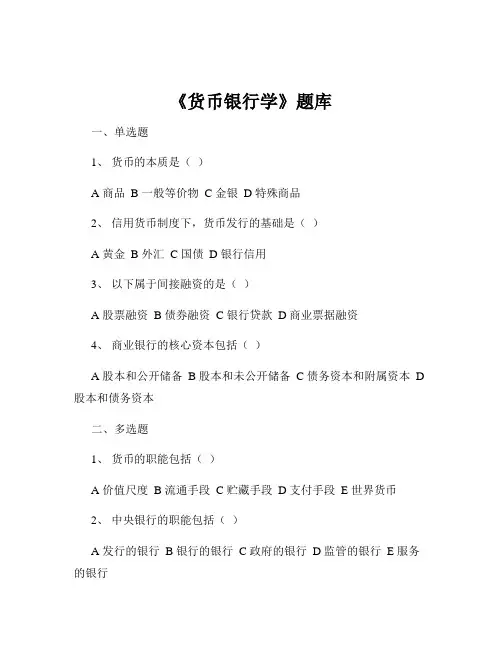
《货币银行学》题库一、单选题1、货币的本质是()A 商品B 一般等价物C 金银D 特殊商品2、信用货币制度下,货币发行的基础是()A 黄金B 外汇C 国债D 银行信用3、以下属于间接融资的是()A 股票融资B 债券融资C 银行贷款D 商业票据融资4、商业银行的核心资本包括()A 股本和公开储备B 股本和未公开储备C 债务资本和附属资本D 股本和债务资本二、多选题1、货币的职能包括()A 价值尺度B 流通手段C 贮藏手段D 支付手段E 世界货币2、中央银行的职能包括()A 发行的银行B 银行的银行C 政府的银行D 监管的银行E 服务的银行3、金融市场的构成要素包括()A 交易主体B 交易对象C 交易工具D 交易价格E 交易组织形式4、商业银行的负债业务包括()A 存款业务B 借款业务C 自有资本D 票据贴现E 证券投资三、判断题1、货币的出现解决了商品交换中的等价交换问题。
()2、基准利率是在整个利率体系中起主导作用的利率。
()3、商业银行的经营原则是安全性、流动性和盈利性,其中安全性是首要原则。
()4、通货膨胀一定意味着物价上涨。
()四、简答题1、简述货币制度的构成要素。
2、简述商业银行的主要业务。
3、简述中央银行的货币政策工具。
4、简述通货膨胀的成因。
五、论述题1、论述货币供求与均衡的关系。
2、论述金融创新对金融监管的影响。
下面我们来逐一分析这些题目:单选题部分:第 1 题,货币的本质是一般等价物,能够表现和衡量其他一切商品的价值,并能和其他一切商品相交换。
选项 B 正确。
第 2 题,在信用货币制度下,货币发行的基础是银行信用,通过银行的信贷活动创造货币。
选项 D 正确。
第 3 题,间接融资是指资金盈余单位与资金短缺单位之间不发生直接关系,而是分别与金融机构发生一笔独立的交易,即资金盈余单位通过存款等方式将资金提供给金融机构,再由金融机构以贷款等形式将资金提供给资金短缺单位。
银行贷款属于间接融资,选项 C 正确。
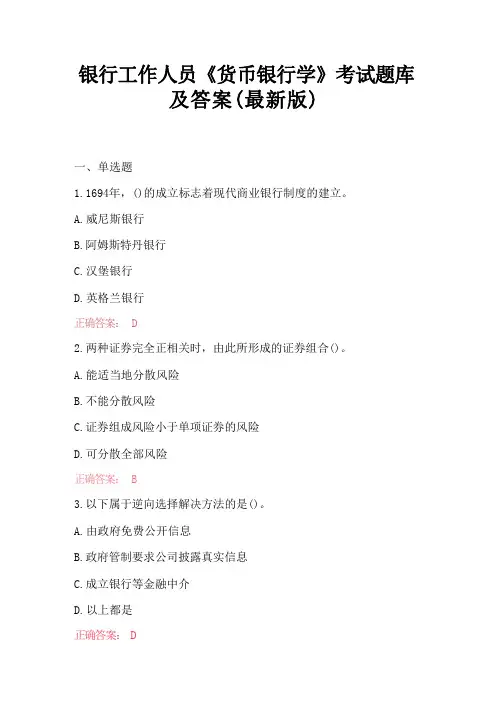
银行工作人员《货币银行学》考试题库及答案(最新版)一、单选题1.1694年,()的成立标志着现代商业银行制度的建立。
A.威尼斯银行B.阿姆斯特丹银行C.汉堡银行D.英格兰银行正确答案:D2.两种证券完全正相关时,由此所形成的证券组合()。
A.能适当地分散风险B.不能分散风险C.证券组成风险小于单项证券的风险D.可分散全部风险正确答案:B3.以下属于逆向选择解决方法的是()。
A.由政府免费公开信息B.政府管制要求公司披露真实信息C.成立银行等金融中介D.以上都是正确答案:D4.典型意义上的储藏手段是针对()而言的。
A.信用货币B.电子货币C.银行券D.铸币正确答案:D5.交易方程式的公式是()。
A.MB.M+V=P+YC.M/VD.MxV=PxY正确答案:D6.按照凯恩斯的观点,利率低于"正常"水平时,人们预期债券价格(),货币需求量()。
A.上升,增加B.上升,减少C.下跌,增加D.下跌,减少正确答案:C7.以下对二级市场功能描述错误的是()。
A.为已发行证券提供流动性场所B.其股票价格指数是国民经济的晴雨表C.融通资金功能D.分散和转移风险功能正确答案:C8.在基础货币一定的条件下,货币乘数越大,则货币供应量()。
A.越多B.越少C.不变D.不一定正确答案:A9.中央银行业务经营的目标是()A.营利B.制定货币政策C.制定、实施、实现货币政策目标D.开展公开市场业务、实现货币政策目标正确答案:C10.一张面额为1000元的一年期的汇票,3个月后到期。
到银行贴现时确定该票据的贴现率为4%,其贴现金额是()A.1000元B.999元C.10元D.990元正确答案:D11.金融监管按大类分可分为证券、保险、()等监管机构A.信托B.银行C.基金D.投资正确答案:B12.对经济运行影响强烈而不常使用的货币政策工具是()A.信用配额B.公开市场业务C.再贴现政策D.存款准备金政策正确答案:A13.1897年在上海成立的()标志着中国现代银行的产生。
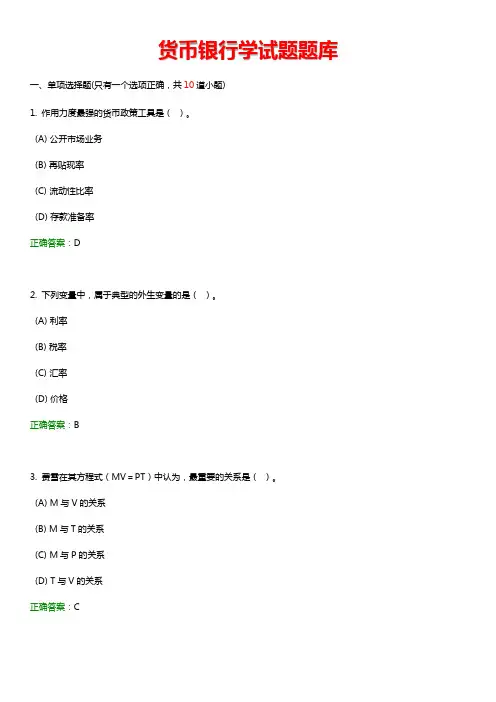
货币银行学试题题库一、单项选择题(只有一个选项正确,共10道小题)1. 作用力度最强的货币政策工具是()。
(A) 公开市场业务(B) 再贴现率(C) 流动性比率(D) 存款准备率正确答案:D2. 下列变量中,属于典型的外生变量的是()。
(A) 利率(B) 税率(C) 汇率(D) 价格正确答案:B3. 费雪在其方程式(MV=PT)中认为,最重要的关系是()。
(A) M与V的关系(B) M与T的关系(C) M与P的关系(D) T与V的关系正确答案:C4. 当银行存款的名义利率和物价变动率一致时,存户到期提取的本利和能够达到()。
(A) 升值(B) 贬值(C) 保值(D) 升值或贬值的幅度不定正确答案:C5. 收入属于货币需求决定因素中的()。
(A) 微观变量(B) 机会成本变量(C) 制度变量(D) 规模变量正确答案:D6. 一般情况下通货比率与收入的变动成()。
(A) 正向(B) 反向(C) 同比例变化(D) 两者无关正确答案:B7. 下列不是凯恩斯提出的货币需求动机的是()(A) 谨慎动机(B) 所得动机(C) 业务动机(D) 偏好动机正确答案:D8. 下列理论及模型中,不属于对凯恩斯“流动性偏好”理论的发展的是()(A) 惠伦模型(B) 托宾模型(C) 货币理论(D) 鲍莫尔模型正确答案:C9. 属于货币学派货币理论的命题是()(A) 利率是货币需求的重要决定因素(B) 实际利率、实际经济增长率都是由经济中的实际因素决定的(C) 货币政策是稳定经济的有效工具,货币当局应根据经济现状及时调整货币政策以适应经济发展(D) “恒久收入”概念是一个不包含人力资本在内的纯物质化的概念正确答案:B10. 在通货膨胀过程中,下列会得到利益的经济个体是()(A) 债权人(B) 浮动收入者(C) 货币财富持有者(D) 靠固定薪金维持生活的人正确答案:B二、判断题(判断正误,共10道小题)11.货币当局可以直接调控货币供给数量。
货币银行学试题题库一、单项选择题(只有一个选项正确,共10道小题)1. 我国城市信用社改组之初,采用了()的过渡名称。
(A) 城市商业银行(B) 城市发展银行(C) 城市投资银行(D) 城市合作银行正确答案:D2. 远期合约买方可能形成的收益或损失状况是()。
(A) 收益无限大,损失有限大(B) 收益有限大,损失无限大(C) 收益有限大,损失有限大(D) 收益无限大,损失无限大正确答案:D3. 下列关于初级市场与二级市场关系的论述正确的是()。
(A) 初级市场是二级市场的前提(B) 二级市场是初级市场的前提(C) 没有二级市场初级市场仍可存在(D) 没有初级市场二级市场仍可存在正确答案:A4. 我过第一家股票上市的商业银行是()。
(A) 上海埔东发展银行(B) 招商银行(C) 深圳发展银行(D) 福建兴业银行正确答案:C5. 我国在()年建立了第一家政策性银行。
(A) 1992(B) 1993(C) 1994(D) 1995正确答案:C6. 普通居民存款属于()。
(A) 活期存款(B) 定期存款(C) 储蓄存款(D) 支票存款正确答案:C7. 下列不属于负债管理理论缺陷的是()。
(A) 提高融资成本(B) 增加经营风险(C) 降低资产流动性(D) 不利于银行稳健经营正确答案:C8. 下列属于短期资金市场的是()。
(A) 票据市场(B) 债券市场(C) 资本市场(D) 股票市场正确答案:A9. 我国财务公司在行政上隶属于()。
(A) 政府部门(B) 中国人民银行(C) 各企业集(D) 商业银行正确答案:C10. 银行买进一张未到期票据,票面额为1万元,年贴现率为10%,票据50天后到期,则银行应向客户支付()。
(A) 9863元(B) 9000元(C) 10000元(D) 9800元正确答案:A二、判断题(判断正误,共10道小题)11.基础货币等与流通中现金与商业银行的存款准备金之和。
()正确答案:说法正确12.货币当局可以直接调控货币供给数量。
《货币银行学》练习题一、单项选择题1.科学的货币本质观是()A.马克思的劳动价值说B.货币金属说C.货币名目说D.创造发明说2.高利贷是一种以()为条件的借贷活动。
A.价值转移B.高利借债和偿还C.价值特殊运动D.支付利息3.银行和企业往往同属一个财团,并与工商企业关系密切的是()金融机构体系的特点。
A.英国B.美国C.日本D中国4.发行价格低于金融工具的票面金额称作()。
A.溢价B.平价C.折价D.竞价5.世界各国中央银行的组织形式以()最为流行。
A.单一型B.复合型C.跨国型D.准中央银行型6.商业银行经营方针中作为条件的是()。
A.安全性B.社会性C.流动性D.盈利性7.在影响基础货币增减变动的因素中,()的影响最主要。
A.国外净资产B.央行对政府债权C.固定资产的增减变化D.央行对商业银行的债权8.()是国际收支平衡表的最基本项目。
A.经常项目B.资本项目C.平衡项目D.以上都不对9.物价水平年平均上涨率在3%以上,但尚未达到两位数的通货膨胀属于()。
A.爬行式通货膨胀B.温和式通货膨胀C.奔腾式通货膨胀D.恶性通货膨胀10.利率与货币供应量作为政策变量的不同点是()。
A.前者顺循环,后者逆循环B.前者逆循环,后者顺循环C.二者均顺循环,但程度不一样D.二者均逆循环,但程度不一样11.商品的价格是()。
A.商品与货币价值的比率B.同商品价值成反比C.同货币价值成正比D.商品价值的货币表现12.经济发展对金融起()作用。
A.一定的B.决定性的C.不确定D.推动13.下列利率决定理论中哪一种理论强调投资与储蓄对利率的决定作用()。
A.马克思的利率论B.流动偏好论C.可贷资金论D.实际利率论14.现代经济中最基本的占主导地位的信用形式是()。
A.国家信用B.商业信用C.银行信用D.国际信用15.下列项目中的()不包括在国际收支平衡表中。
A.经常项目B.资本项目C.借贷项目D.平衡项目16.中央银行是发行的银行,拥有发行()的权力。
《货币银行学》复习资料一、关于名词解释(每小题3分,共15分),1,无限法偿:货币具有的法定支付能力,指不论用于何种支付,不论支付数额有多大,对方均不得拒绝接受,是有限法偿的对称。
2,货币政策:即中央银行为实现既定的目标运用各种工具调节货币供应量,进而影响宏观经济运行的各种方针措施。
3,基础货币:又称强力货币或高能货币,是指处于流通领域为社会公众所持有的现金及银行体系准备金(包括法定存款准备金和超额准备金)的总和,是整个银行体系内存款扩张、货币创造的基础。
4,派生存款:原始存款的对称,指由商业银行发放贷款、办理贴现或投资等业务活动引申而来的存款。
派生存款产生的过程,就是商业银行吸收存款、发放贷款、形成新的存款额,最终导致银行体系存款总量增加的过程。
5,原始存款:商业银行接受的客户以现金方式存入的存款和中央银行对商业银行的再贴现或再贷款而形成的准备金存款。
原始存款是商业银行从事资产业务的基础,也是扩张信用的源泉。
6,直接融资:资金供求双方通过特定的金融工具直接形成债权债务关系或所有权关系的融资形式。
其工具主要有商业票据、股票、债券等。
7,经济货币化:是指一国国民经济中用货币购买的商品和劳务占其全部产出的比重及其变化过程。
8,经济金融化:是指全部经济活动总量中使用金融工具的比重。
9,证券行市:在二级市场上买卖有价证券时的实际交易价格。
证券行市往往高于或低于其票面金额。
对发行人和投资者来说,证券行市是最为重要的,它不仅影响该证券新的发行价格,而且是影响投资决策的主要因素。
10,金融结构:是指构成金融总体的各个组成部分的分布、存在、相对规模、相互关系与配合的状态。
11,直接标价法:以一定单位的外国货币为基准来计算应付多少单位的本国货币,亦称应付标价法。
在直接标价法下,汇率越高,单位外币所能兑换的本国货币越多,表示外币升值而本币贬值,反之则反是。
12,间接标价法:以一定单位的本币为基准来计算应收多少外币,亦称应收标价法。
货币银行学试题库一、单项选择题1.实物货币是指()A 没有内在价值的货币B 不能分割的货币C 专指贵金属货币D 作为货币其价值与普通商品价值相等的货币2.货币作为价值尺度所要解决的是()A 实现商品的交换B 表现特定商品的价值C 在商品之间进行价值比较D 使人们不必对商品进行比较3.商品流通与物物交换的区别在于()A 前者包括许多商品的交换。
B 前者是指以货币为媒介的商品交换的总体,后者则是只包括两种商品。
C 前者是指以货币为媒介的商品交换的总体,后者则是不以某种商品为媒介的各种商品之间的交换。
D前者是指不以货币为媒介的商品交换的总体,后者则是没有货币的两种商品之间的交换。
4.劣币是指实际价值()的货币。
A 等于零B 等于名义价值C 高于名义价值D 低于名义价值5.本位货币是指()A 一个国家货币制度规定的标准货币B 本国货币当局发行的货币C 以黄金为基础的货币D 可以与黄金兑换的货币6.金银复本位制是()A 金银比价由政府和市场共同决定的金银两本位制。
B 金银的比价由市场决定的金银两本位制。
C 金银的比价由政府规定的金银两本位制。
D 金银比价由银行决定的金银两本位制。
7.跛行本位制是指()A 银币的铸造受到控制的金银两本位制。
B 金币的铸造受到控制的金银两本位制。
C 以金币为本位货币的金银两本位制。
D 以银币为本位货币的金银两本位制。
8.纸币本位币制是指()A 银行券为本位货币B 可以自由兑换黄金的货币为本位货币C 信用货币为本位货币D 纸币为本位货币9.典型的金本位制是()A 金块本位制B 金汇兑本位制C 虚金本位制D 金币本位制10.本位货币在商品流通和债务支付中具有()的特点。
A 有限法偿B 无限法偿C 债权人可以选择是否接受D 债务人必须支付11. 信用起源于()A 商品交换B 货币流通C 生产社会化D 私有制12.在信用关系的价值运动中,货币执行的职能是()A 价值尺度B 流通手段C 支付手段D 储藏手段13.美国同业拆借市场也称()A 贴现市场B 承兑市场C 联邦基金市场D 外汇交易市场14.资本市场是指()A 短期市场B 一级市场C 发行市场D 长期市场15.结案届融资在于金融中介机构是否发行自己的()A 股票B 支票C 汇票D 债务凭证16.()是提供金融服务和产品的企业。
货币银行学试题及答案一、选择题(每题2分,共20分)1. 货币的最基本的职能是:A. 价值尺度B. 流通手段C. 贮藏手段D. 支付手段2. 以下哪个不是货币市场工具?A. 短期国债B. 长期国债C. 商业票据D. 银行承兑汇票3. 货币供应量通常分为几个层次?A. 1个B. 2个C. 3个D. 4个4. 以下哪个不是中央银行的职能?A. 发行货币B. 制定货币政策C. 监管金融市场D. 经营商业银行业务5. 利率上升时,以下哪个现象最可能发生?A. 投资增加B. 储蓄增加C. 消费减少D. 通货膨胀率上升6. 银行的准备金率提高,通常会导致:A. 货币供应量增加B. 货币供应量减少C. 银行信贷规模扩大D. 银行信贷规模缩小7. 以下哪个是直接融资的特点?A. 通过银行进行B. 需要中介机构C. 风险较低D. 融资成本较高8. 以下哪个是货币政策的最终目标?A. 稳定物价B. 经济增长C. 充分就业D. 所有以上9. 以下哪个是商业银行的主要业务?A. 投资咨询B. 存款业务C. 保险业务D. 证券交易10. 货币的流通速度越快,货币供应量对经济的影响:A. 越小B. 越大C. 没有影响D. 取决于其他因素答案:1-5 ABBCD 6-10 BDBBD二、判断题(每题1分,共10分)1. 银行的信用创造功能是指银行可以通过贷款来增加货币供应量。
(对)2. 货币政策的三大工具是公开市场操作、存款准备金率和再贴现率。
(对)3. 货币供应量M1包括现金和活期存款。
(对)4. 利率市场化是指利率完全由市场供求关系决定。
(对)5. 银行的不良贷款率越高,其信用风险越低。
(错)6. 通货膨胀是指货币供应量超过经济增长速度,导致物价水平持续上涨的现象。
(对)7. 银行的资本充足率越高,其抵御风险的能力越强。
(对)8. 货币的贮藏手段职能是指货币可以作为价值的储存工具。
(对)9. 货币的流通手段职能是指货币作为交换媒介的功能。
货币银行学题库及答案详解货币银行学题库单选题1.国民待遇条款一般不适用于()A.外国产品所应缴纳的国内税捐B.船舶在港口的待遇C.商标注册、著作权的保护D.购买土地权2.下列对于倾销的说法不正确的是()A.倾销是指厂商对其出口的产品制定一个其在国内市场更低的价格的行为B.倾销行为实际上是厂商利润最大化战略的体现C.倾销行为的成立必须是在不完全竞争行业D.倾销行为是一种公平的贸易行为,因此被广泛运用3.给定一个劳动需求函数,根据所画的劳动力需求曲线,有()A.价格水平上升,名义工资不变,则劳动需求量减少B.价格水平上升,名义工资不变,则劳动需求量增加C.价格水平和名义工资同比例增加时,劳动需求量增加D.价格水平和名义工资同比例增加时,劳动需求量减少4.假定经济已经实现了充分就业且总供给曲线是垂直线,扩张性货币政策效应是()A.提高价格水平和实际产出B.提高价格水平但不影响实际产出C.提高实际产出但不影响价格水平D.对价格水平和产出均无影响5.二级市场的组织形态有两种,一种是交易所,证券的买主和卖主或是代理人在交易所的一个中心地点见面并进行交易,另一种交易形式是()A.场外交易市场B.有形市场C.第三市场D.第四市场6.世界上成立的第一家股票交易所是在()A.纽约B.伦敦C.巴黎D.阿姆斯特丹7.中国人自己创办的第一家证券交易所是1918 年夏天成立的()A.上海证券交易所B.上海众业公所C.上海华商证券交易所D.北平证券交易所8.在我国,证监会属于()管辖。
A.中国人民银行B.国务院C.人大常委会D.国家主席9.股票的理论价值是()A.票面价值B.账面价值C.清算价值D.内在价值10.中央银行在证券市场上买卖有价证券是在开展它的()业务。
A.政策性B.公开市场操作C.投资性D.保值11.以下关于金融工具的说法中,错误的是()A.按融资方式划分,企业债券属于直接融资工具B.按融资方式划分,股票属于间接融资工具C.按期限长短划分,回购协议属于短期金融工具D.按投资人所拥有的权利划分,证券投资基金是混合工具12.贴现债券通常(),是一种折价发行的债券。
1)Of the following measures of interest rates, which is considered by economists to bethe most accurate?(a)The yield to maturity(b)The coupon rate(c)The current yield(d)The yield on a discount basisAnswer:AQuestion Status: Previous Edition2)To claim that a lottery winner who is to receive $1 million per year for twenty yearshas won $20 million ignores the concept of(a)amortizing a loan.(b)par value.(c)deflation.(d)discounting the future.(e)face value.Answer:DQuestion Status: New3)If a security pays $110 next year and $121 the year after that, what is its yield tomaturity if it sells for $200?(a)9 percent(b)10 percent(c)11 percent(d)12 percentAnswer:B4)Which of the following are true of simple loans?(a)A simple loan requires the borrower to repay the principal and interest at thematurity date.(b)Commercial loans to businesses are often of this type.(c)The borrower repays the loan by making the same payment every month.(d)Both (a) and (b) of the above.(e)Both (b) and (c) of the above.Answer:DQuestion Status: Previous Edition5)For simple loans, the simple interest rate is _____ the yield to maturity.(a)greater than(b)less than(c)equal to(d)not comparable toAnswer:C6)Question Status: Previous Edition With an interest rate of 5 percent, the present valueof $100 next year is approximately(a)$100.(b)$105.(c)$95.(d)$90.Answer:C7)If $1102.50 is the amount payable in two years for a $1000 simple loan made today,the interest rate is(a)2.5 percent.(b)5 percent.(c)10 percent.(d)12.5 percent.(e)20 percent.Answer:B8) A loan that requires the borrower to make the same payment every period until thematurity date is called a(a)simple loan.(b)fixed-payment loan.(c)discount loan.(d)a same-payment loan.(e)none of the above.Answer:B9) A coupon bond pays the owner of the bond(a)the same amount every month until maturity date.(b)the face value of the bond plus an interest payment once the maturity date hasbeen reached.(c)a fixed-interest payment every period and repays the face value at the maturitydate.(d)the face value at the maturity date.(e)none of the above.Answer:C10)Which of the following are true for a coupon bond?(a)When the coupon bond is priced at its face value, the yield to maturity equals thecoupon rate.(b)The price of a coupon bond and the yield to maturity are negatively related.(c)The yield to maturity is greater than the coupon rate when the bond price is belowthe par value.(d)All of the above are true.(e)Only (a) and (b) of the above are true.Answer:DQuestion Status: Previous Edition11)The price of a consol(a)equals the coupon payment times the interest rate.(b)equals the coupon payment plus the interest rate.(c)equals the coupon payment minus the interest rate.(d)equals the coupon payment divided by the interest rate.(e)cannot be determined.Answer:D12) A consol paying $1 annually when the interest rate is 4 percent has a price of(a)$4.(b)$20.(c)$25.(d)$100.(e)$400.Answer:C13)Which of the following $1,000 face-value securities has the highest yield tomaturity?(a)A 5 percent coupon bond selling for $1,000(b)A 10 percent coupon bond selling for $1,000(c)A 15 percent coupon bond selling for $1,000(d)A 15 percent coupon bond selling for $900Answer:D14)Which of the following bonds would you prefer to be buying?(a)A $10,000 face-value security with a 6 percent coupon selling for $10,000(b)A $10,000 face-value security with a 7 percent coupon selling for $10,000(c)A $10,000 face-value security with a 9 percent coupon selling for $10,000(d)A $10,000 face-value security with a 10 percent coupon selling for $10,000(e)A $10,000 face-value security with a 10 percent coupon selling for $9,000Answer:EQuestion Status: New15)Which of the following bonds would you prefer to be selling?(a)A $10,000 face-value security with a 6 percent coupon selling for $10,000(b)A $10,000 face-value security with a 6 percent coupon selling for $9,000(c)A $10,000 face-value security with a 6 percent coupon selling for $11,000(d)A $10,000 face-value security with a 7 percent coupon selling for $10,000(e)A $10,000 face-value security with a 7 percent coupon selling for $9,000Answer:C16) A credit market instrument that pays the owner the face value of the security at thematurity date and nothing prior to then is called a(a)simple loan.(b)fixed-payment loan.(c)coupon bond.(d)discount bond.Answer:D17)Examples of discount bonds include(a)U.S. Treasury bills.(b)U.S. savings bonds.(c)zero-coupon bonds.(d)all of the above.(e)only (a) and (b) of the above.Answer:D18)If a $10,000 face-value discount bond maturing in one year is selling for $5,000, thenits yield to maturity is(a)5 percent.(b)10 percent.(c)50 percent.(d)100 percent.Answer:D19) A discount bond selling for $15,000 with a face value of $20,000 in one year has ayield to maturity of(a)3 percent.(b)20 percent.(c)25 percent.(d)33.3 percent.(e)66.7 percent.Answer:D20)Which of the following are true for the current yield?(a)The current yield is defined as the yearly coupon payment divided by the price ofthe security.(b)The formula for the current yield is identical to the formula describing the yield tomaturity for a consol.(c)The current yield will be a close approximation for the yield to maturity thelonger the time to maturity, and the closer the bond price to its par value.(d)All of the above are true.(e)Only (a) and (b) of the above are true.Answer:D21)The current yield, which equals the coupon payment divided by the price of a couponbond, is a less accurate measure of the yield to maturity the ______ the maturity of the bond and the ______ the price is from/to the par value.(a)shorter; closer(b)shorter; farther(c)longer; closer(d)longer; fartherAnswer:B22)The _____ is a better approximation fo r the _____, the nearer the bond’s price is tothe bond’s par value and the longer the maturity of the bond.(a)current yield; yield to maturity(b)current yield; coupon rate(c)yield to maturity; current yield(d)yield to maturity; coupon rateAnswer:A23)The current yield on a $10,000, 10 percent coupon bond selling for $5,000 is(a)30 percent.(b)33 percent.(c)60 percent.(d)20 percent.Answer:D24) A problem with the yield on discount basis is that it __________ the yield to maturity,and this __________ increases, the ___________ the maturity of the discount bond.(a)understates; understatement; longer(b)understates; understatement; shorter(c)overstates; overstatement; longer(d)overstates; overstatement; shorter(e)approximates; approximation; longerAnswer:A25)The yield on a discount basis of a 90-day $1,000 Treasury bill selling for $900 is(a)10 percent.(b)20 percent.(c)25 percent.(d)40 percent.Answer:D26)An equal increase in all bond interest rates(a)increases the price of a five-year bond more than the price of a ten-year bond.(b)i ncreases the price of a ten-year bond more than the price of a five-year bond.(c)decreases the price of a five-year bond more than the price of a ten-year bond.(d)d ecreases the price of a ten-year bond more than the price of a five-year bond.(e)increases all bond prices by the same dollar amount.Answer:D27)The return on a 5 percent coupon bond that initially sells for $1,000 and sells for $950next year is(a)-10 percent.(b)-5 percent.(c)0 percent.(d)5 percent.Answer:C28)Which of the following are generally true of all bonds?(a)The only bond whose return equals the initial yield to maturity is one whose timeto maturity is the same as the holding period.(b)A rise in interest rates is associated with a fall in bond prices, resulting in capitallosses on bonds whose terms to maturity are longer than the holding periods.(c)The longer a bond’s maturi ty, the smaller is the size of the price changeassociated with an interest rate change.(d)All of the above are true.(e)Only (a) and (b) of the above are true.Answer:E29)The nominal interest rate minus the expected rate of inflation(a)defines the real interest rate.(b)is a better measure of the incentives to borrow and lend than is the nominalinterest rate.(c)is a more accurate indicator of the tightness of credit market conditions than is thenominal interest rate.(d)indicates all of the above.(e)indicates only (a) and (b) of the above.Answer:D30)In which of the following situations would you prefer to be the lender?(a)The interest rate is 9 percent and the expected inflation rate is 7 percent.(b)The interest rate is 4 percent and the expected inflation rate is 1 percent.(c)The interest rate is 13 percent and the expected inflation rate is 15 percent.(d)The interest rate is 25 percent and the expected inflation rate is 50 percent.Answer:B31)If you expect the inflation rate to be 4 percent next year and a one year bond has ayield to maturity of 7 percent, then the real interest rate on this bond is(a)-3 percent.(b)-2 percent.(c)3 percent.(d)7 percent.Answer:C。